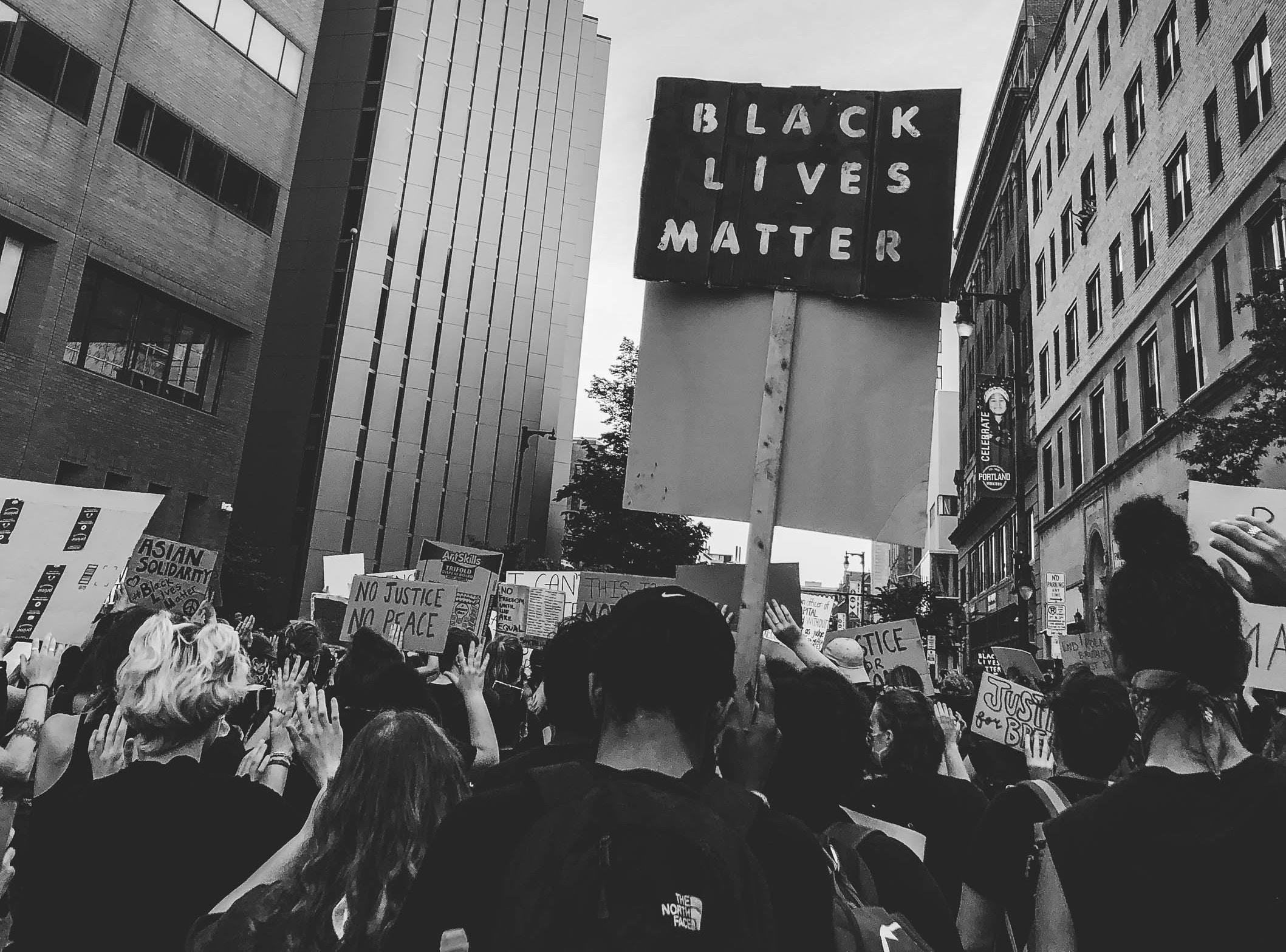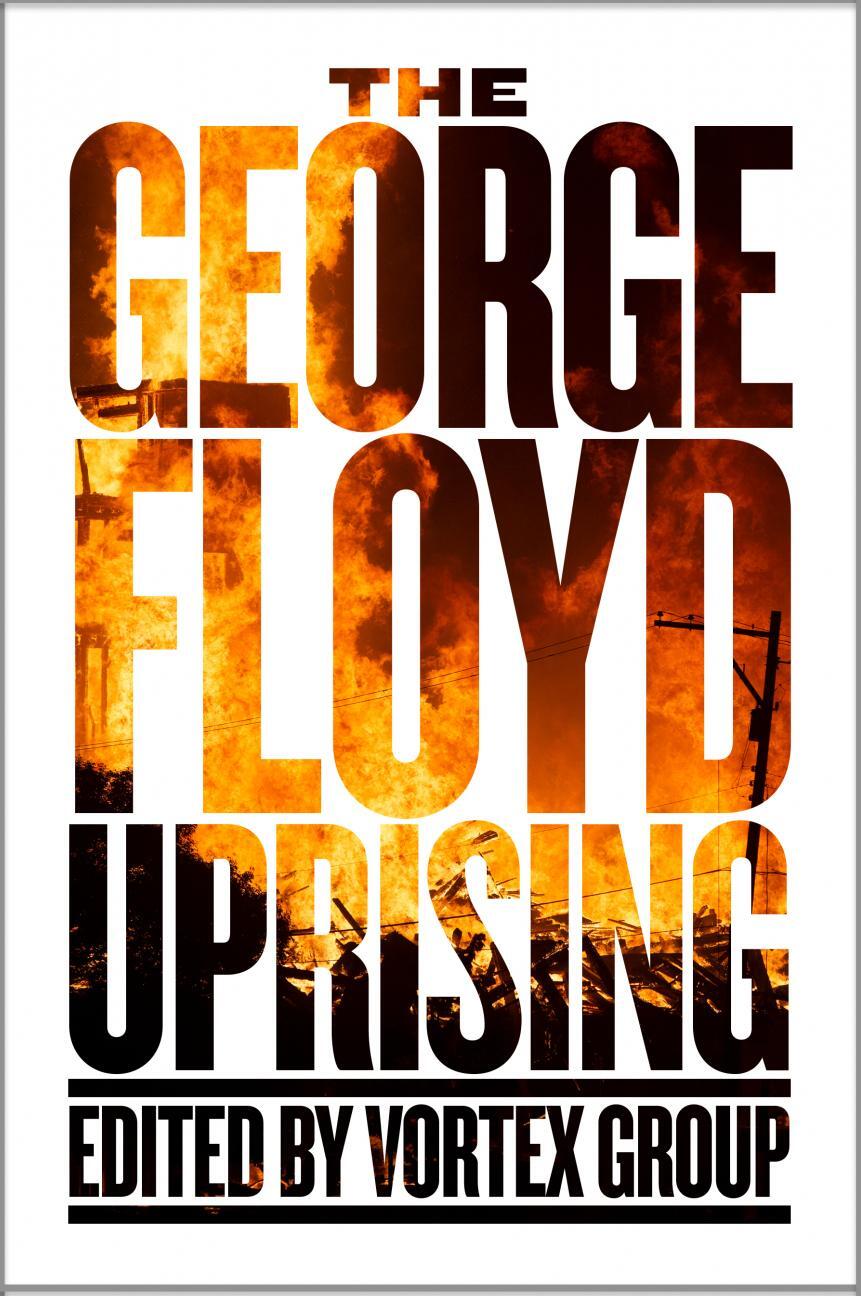The George Floyd Uprising
Edited by Vortex Group
PM Press, $22.95 (paper)
I kind of missed the George Floyd uprising. I was in the United States, but in jail at the time, so I don’t have firsthand experience of what went on in the streets. Of course, we knew about it in jail, and followed it as closely as we could. It was impossible not to hear about the rebellion that summer, or get drawn in by it. Even people who tended not to be very interested in politics soon found themselves marching in the streets for Black lives and against the police amid looted businesses and the looming husks of burned-out cruisers, paddy wagons, and even precincts.
The multiracial everyperson quality of the crowds who carried out the uprising is a major theme of Vortex Group’s The George Floyd Uprising, an anthology that offers a transporting account of the revolutionary strategies used during the uprisings, and published largely anonymously. The race and class analyses presented in the book’s articles are as heterogeneous as the texts that constitute them, but they tend to agree on this. Another leitmotif is the repressive, reformist role of nonprofit organizations and the moderate Black middle class. Another is the function of white people in a radical movement led by the Black working class. Yet another, how the uprising was a laboratory for thoroughly U.S. applications of protest tactics honed in places like Hong Kong and Chile, and “developed by anarchists and their fellow travelers over the last twenty years.”
The George Floyd Uprising is divided into three sections and consists of nineteen texts, almost all originally published in the radical leftist magazines Ill Will and It’s Going Down.
The first part, “First There Was Fire,” contains five pieces written in the summer of 2020. They provide a bird’s-eye view of the uprising and dissect the various narratives that arose around it as it was happening. This section includes “The Siege of the Third Precinct in Minneapolis,” a marvelous admixture of context, firsthand narrative, and analysis, laying out the various roles that protesters took on (medical support, scanner monitors, Telegram channel operators, peaceful protesters, ballistic squads, laser pointers, barricaders, sound systems, looters, fire-setters) as well as the “battlefield” strategies and tactics that led to the movement’s first great victory, from which the essay takes its name.
Jarrod Shanahan and Zhandarka Kurti’s “Prelude to a Hot American Summer” situates the uprising in the economic context of the past few decades (austerity, with funding shifting from social services to police and prisons) and months (precarity, due mostly to COVID-19). The essay culminates in a robust analysis of how to sustain and concretize the newly widespread vision of a world without police. This entails the application of non-reformist reforms, long a central plank of abolitionist thought, foremost of which is to “starve the beast,” in the words of sociologist Alex Vitale. “By taking aim at police budgets,” Shanahan and Kurti write, “the vanguard of the anti-police movement is launching what could potentially become the opening salvo against the capitalist social order that makes police necessary.”
Among the other entries in this section, I appreciated the clarity and concision of the itemized twenty-four “Theses on the George Floyd Rebellion,” which lays out how “abolition occurred from May 26 to June 1” and defends the movement’s spontaneity against claims that it was organized by the revolutionary left, nonprofits, or “outside agitators.”
More from our decarceral brainstorm
Every week, Inquest aims to bring you insights from people thinking through and working for a world without mass incarceration.
Sign up for our newsletter for the latest.
Newsletter
The most original and thought-provoking of the pieces in the first section is “How It Might Should Be Done,” by Idris Robinson. In a wide-ranging essay neatly divided into ten segments, Robinson convincingly argues, for example, that the real danger of obscuring (and hence forgetting) the uprising’s insurrectionary character comes from U.S. liberals, uncomfortable as they are with any substantive systemic change. It is, counterintuitively, the conservatives so loudly crying foul that attest to the fact that “a militant nationwide uprising did in fact occur.” Robinson also writes that one reason the uprising was so successful as an insurrectionary abolitionist movement was precisely because it largely avoided the sort of discourse that might be referred to as identity politics, and that moving forward entails coordinating a multitude of tactics and struggles like rent strikes, Twitter hacks, and even our ethical obligation to the millions killed by U.S. white supremacy. “While spearheaded by a Black avant-garde,” writes Robinson, “this largely multiethnic rebellion managed to spontaneously overcome codified racial divisions.”
The anthology’s second section, “Report Backs,” which forms the central bulk of the book, is a collection of nine retellings of the uprising as it played out in Atlanta, Kenosha, Louisville, Minneapolis, New York, Philadelphia, and Portland. The New York Post-Left’s “Welcome to the Party” is particularly jam-packed with descriptions of surreal images of the New York streets: looted luxury boutiques and burning cruisers in SoHo, flaming barricades outside the famous Strand Bookstore. The essay’s authors situate what they refer to as “social looting” in the context not only of social justice but of breaking out of New York’s stringent quarantine measures, and focus on debunking the unhelpful distinction between “good protestors” and “bad protestors” (i.e., looters). This distinction, a kind of holdover from a politics of respectability, was ultimately one of the things that hamstrung the rebellion in the five boroughs, delegitimizing the useful anti-capitalist work of looting, which among other things can function as a smokescreen for those doing more overtly political kinds of rebellion. Four brief bullet-point paragraphs continue this kind of critical thinking by picking apart the conspiratorial worries about “outside agitators,” the focus on abolition as the end goal, and the organic, spontaneous nature of the rebellion. As much as there were any leaders in New York, they were the Black proletarian youths leading entire crowds in simple but unmistakable chants of “NYPD suck my dick!”
The third part of The George Floyd Uprising, “Strategies and Tensions,” attempts to draw conclusions about which revolutionary strategies should be relied upon to sustain the movement’s momentum. It’s a thorny question: How to keep a spontaneous rebellion’s demands alive without consigning them to the graveyard of reform? The authors are generally cautious in their proposals. Of the essays in this section, one of the more compelling is “The Return of John Brown,” whose authors place themselves in the somewhat delicate position of discussing the role white accomplices can play in an abolitionist struggle led by the Black working class.
Some of the essays in this section contain a good deal of the sort of lofty, even esoteric revolutionary language that I generally find palatable in small doses, but which in larger amounts causes my eyes to roll up into my head. It makes sense that this section has the most abstract and sometimes unapproachable language—it’s the theory part, after all—but it’s also the least accessible section. An exception is Adrian Wohlleben’s “Memes without End,” which concludes the book. Dated May 2021, this is by far the most recent text. It is also the most detailed about the tension between insurrectionary action and sustaining revolutionary momentum. Wohlleben lays out four simple observations at the start of his piece: that “insurrection today depends less upon the consolidation of leading identities than on the circulation of leading practices or gestures”; that the rebellion began not as a set of abolitionist demands but rather an explosion of destructive anti-police energy; that counterinsurgency also comes from within in the form of the urge to affiliate with “recognizable frameworks”; and that the movement could be divided into “political riots” and “storefront riots.” The first point—that the model for insurrectionary action now consists of replicating revolutionary gestures in the street, as we saw in the Floyd uprising or in the French Yellow Vests protests before it—is the most compelling. Wohlleben focuses on the power of these sorts of viral rebellious gestures to invite others to participate in a highly intimate way that crosses all lines of identity, and gives some examples, like car caravans, mass transit fare evasions, black blocs, and plaza occupations.
The anthology seeks to understand how to sustain the revolutionary abolitionist momentum of the rebellion, and the inherent contradiction and cooptation that institutionalizing an insurrectionary movement entails. This is the burning question at the heart of the book; it is arguably the question the abolitionist movement now faces. Three years after the uprising, though the abolition dialogue is richer than ever—a slew of books on the topic has been published since 2020—its concrete gains are harder to tally. Take the Minneapolis Police Department, whose abolishment, and replacement by a public safety department, was seriously contemplated by voters in the wake of the protests. But the ballot measure was defeated, and the Justice Department’s recent scathing report shows that the department remains largely unchanged. Serious proposals to defund the police and reinvest in communities have all but disappeared from the national policy dialogue, and where they remain, they’ve largely been defanged and hollowed out. The only voices now claiming that effective police reforms have been implemented since Floyd’s death (which, by the way, was not the goal of the uprising) seem to skew right of center and demand, unsurprisingly, more funding for cops.
The wealth of irreplaceable firsthand knowledge presented in The George Floyd Uprising seeks, in a sense, to wind back the clock, bringing us back to the moment when anything seemed possible, so that we can reevaluate those strategies and carry forward the ones that remain valuable in our present moment.
Even by the standards of anthologies, The George Floyd Uprising is a notably heterogeneous text, a fact acknowledged head-on in the book’s introduction. At times, it can feel dizzying to try to take in all the diverse and even contradictory perspectives. Add to this the fact that the pages are also brimming over with surreal, fantastic scenes—roving bands of skateboarding looters, lines of hot rods revving their engines as the crowd whips itself into a frenzy, protesters pumping iron in a ransacked Planet Fitness, a young Minneapolis man concluding his phone call amid the protests with: “Mom, I have to go. Fuck the police.” Taken together, I sometimes felt as if I were suffering from some kind of text-induced whiplash, the sort of thing you might expect from a Thomas Pynchon novel. It’s a lot to take in.
For this reason, it might have been helpful to include a timeline of the major events of the rebellion: Floyd’s murder on May 25; the eruption of protests in other cities; the broadening of demands to include justice for other victims of police brutality such as Rayshard Brooks, Jacob Blake, Ahmaud Arbery, and Breonna Taylor; the establishment’s overtures of meeting abolitionist demands; the more explicitly antifascist turn the struggle took in places like Portland later that year. This is perhaps a missed opportunity, as no such timeline seems to yet exist. The single most comprehensive source of chronological information on the uprising available online seems to be Wikipedia—perhaps no surprise, for a largely decentralized grassroots political movement—but the article doesn’t include a timeline. The New York Times has a fairly comprehensive one, but it only goes up to June 6, and of course the New York Times has never been known for its revolutionary or abolitionist sympathies.
A surprising oversight of the book is the absence of a chapter on how the rebellion played out in Richmond, Virginia, erstwhile capital of the Confederacy. Perhaps it’s just my bias as a Virginia native, but Richmond was the central battleground that summer in how we reckon with symbols of white supremacy in public places. Numerous monuments to historical racism were defaced and pulled down by crowds there, yet the city merits only passing mention in the anthology.
Nonetheless, The George Floyd Uprising offers an incredible trove of primary source documents of every conceivable tone, from the sober to the bombastic, and every possible type, from blow-by-blow report backs to profound, seething historical analyses. It is most especially the numerous firsthand accounts in Part Two that give the book so much depth and texture.
Reading a book such as this—about a world-historical set of events that, in a certain sense, happened to all of us—it is almost impossible to not import one’s own experiences. And while I wasn’t able to participate in the uprising as it was happening, when I read “In the Eye of the Storm”—a report back from Kenosha, Wisconsin—I couldn’t help but think of a phone call I’d had from jail during the rebellion with my great-aunt and -uncle, who live near there. They’re an elderly white couple with deep local roots and staunch radical sympathies. This particular call took place after the rioting in Kenosha had started, and my great-uncle, Joe, mentioned with a certain sadness that the small business he and his wife had frequented for all their photography needs for the past fifty years had been burned down by rioters the night before. Many pieces in the anthology discuss the unfortunate destruction of small businesses by quoting anarchist theorist Alfredo Bonanno, who “likens the earliest eruptions of revolutionary violence to ‘a blow of the tiger’s claws that rips and does not distinguish.’” Those words wouldn’t come to me then. But my white-bread, corn-fed, octogenarian great-uncle was already ahead of me: As I stuttered, trying to find something comforting but noncommittal to say, he cut me off. “Listen,” he declared in his folksy flatland accent, “I don’t see any difference between what these people did and what Nat Turner did back in 1830-something. They’re fighting for their freedom, and I sure hope they get it.” His response reminded me that there have always been those of us outside the struggle for Black liberation who understand and support it—and some in unexpected places. There’s just never been enough of us.
If there’s one thing the George Floyd rebellion taught us, it’s that that may (hopefully) be beginning to change. For a moment, we made the white supremacist power structure tremble. For that, they would just as soon that we forgot that lesson, or even forgot the uprising entirely. Whatever the right strategy for sustaining that momentum may be, seizing the power of that revolutionary moment starts with remembering and understanding it, for which Vortex Group’s anthology is a great starting point—even if, unlike me, you were actually there.
Image: Mercedes Mehling/Unsplash


